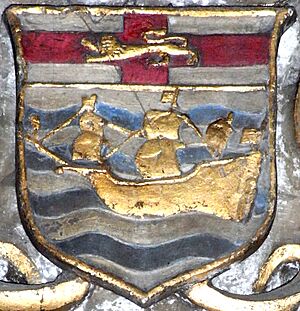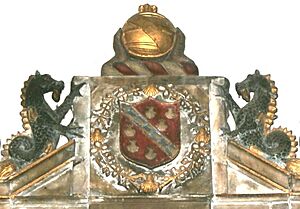Spanish Company facts for kids


The Spanish Company was an English trading group formed a long time ago, in 1530. It was later re-established in 1605 with a long name: President, Assistants and Fellowship of Merchants of England trading into Spain and Portugal. Its main goal was to control and make it easier for English merchants to trade with Spain and Portugal. It did this by creating a special group of approved merchants who had the only right to trade there. This kind of group, given special permission by the King or Queen, is called a chartered company.
Contents
A Look Back: How the Company Started
The Spanish Company was given permission to operate through several special documents called "charters." These charters were like official rulebooks from the King or Queen.
- 1530: King Henry VIII first gave permission for the company to exist.
- 1577: Queen Elizabeth I renewed this permission.
- 1604: King James I confirmed the company again. This happened after a war between England and Spain ended. However, this charter had some mistakes.
- 1605: King James I issued a brand new charter to fix the problems from the 1604 one. This new charter officially restarted the company.
Who Started the Company in 1605?
When the company was officially restarted in 1605, it had 557 founding members. These members were split into two main groups: important people from the government and many merchants from different English towns.
Important People and Royal Officials
About 25 of the founding members were important nobles and officials who worked for the King. Some of these included:
- Thomas Sackville, 1st Earl of Dorset, who was in charge of the country's money.
- Charles Howard, 1st Earl of Nottingham, who was the head of the navy.
- Robert Cecil, 1st Earl of Salisbury, a key advisor to the King.
- Sir Edward Coke, who was the King's top lawyer.
- Other important knights and officials who helped run the country.
Merchants from English Towns
The other 532 founding members were merchants from 16 different English ports and towns. These merchants were the ones who would actually do the trading. The largest groups came from:
- London (224 members)
- Bristol (97 members)
- Exeter, Devon (45 members)
Other towns like Plymouth, Kingston-upon-Hull, Tiverton, and Barnstaple also had merchants who were founding members.
What the 1605 Charter Said
The 1605 charter from King James I was very important. It explained exactly how the Spanish Company would work. It said that many people who tried to trade with Spain and Portugal didn't know the rules or customs. This caused problems for England and for the King of Spain.
To fix this, the King decided that only members of the Spanish Company could trade with Spain and Portugal. This meant that if you weren't part of the company, you couldn't trade goods in those areas. The charter covered all parts of Spain and Portugal, from one end to the other, and even nearby islands.
The King strictly ordered that no other English subjects, no matter who they were, could trade in Spain or Portugal. If they did, they would face punishment, including fines and even jail time. This rule made sure that the Spanish Company had a complete monopoly (meaning they were the only ones allowed to do something) on this trade.
Making Rules and Laws
The 1605 charter gave the Spanish Company the power to "make, order, and establish statutes, laws, constitutions, and ordinances." This meant they could create their own rules for how trade should happen. These rules had to follow any agreements England had with other countries. They were also meant to help honest merchants and prevent cheating or bad practices.
Collecting Money (Taxes)
The company also had the power to collect money, like a tax, on goods that their members bought or sold. This money was used to cover the company's costs and pay its officials. It helped the company run smoothly and for the benefit of all its members.
Power to Punish
The charter allowed the company to "chastise and correct by imprisonment or otherwise by fine, amercement, or other reasonable punishment." This meant they could punish members who broke the rules. They could fine them, make them pay money, or even put them in prison.
Instructions for English Ports
The 1605 charter also gave clear instructions to customs officers in English ports. These officers were told not to allow any goods to be sent to Spain or Portugal unless they belonged to a member of the Spanish Company. This rule helped enforce the company's monopoly and made sure only approved merchants were trading.
Company Representatives Abroad
The Spanish Company was given the power to set up its own consuls and governors in Spain and Portugal. These representatives were there to help company members with their business. They would also settle any arguments or problems that came up between merchants in those countries. This helped ensure fair and quick justice for English traders abroad.
Company Symbols (Armorials)
The Spanish Company had its own special symbols, known as armorials or a coat of arms.
- The main shield showed a ship with three masts sailing on a blue sea, with a dolphin's head appearing from the water. The ship's sails had red crosses on them. In the sky, there was a shining sun and a star. At the top of the shield, there was a red cross with the English lion, a symbol of England.
- The crest, which sits above the shield, showed two arms coming out of clouds, holding a golden globe.
- The supporters, which hold up the shield, were two silver sea horses with golden fins.

